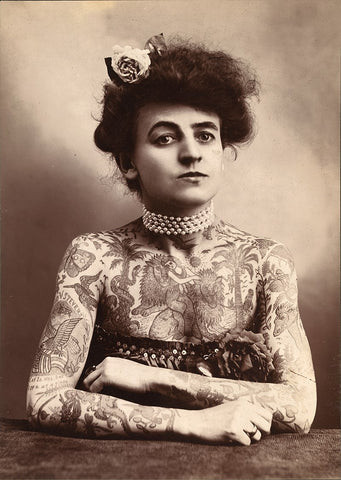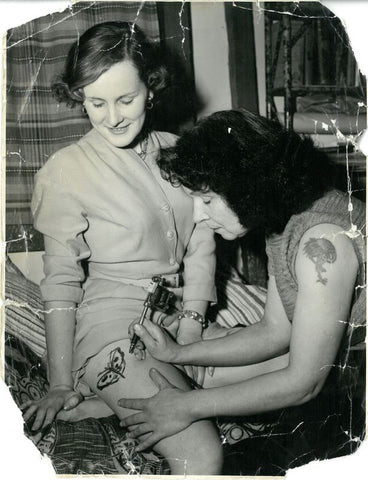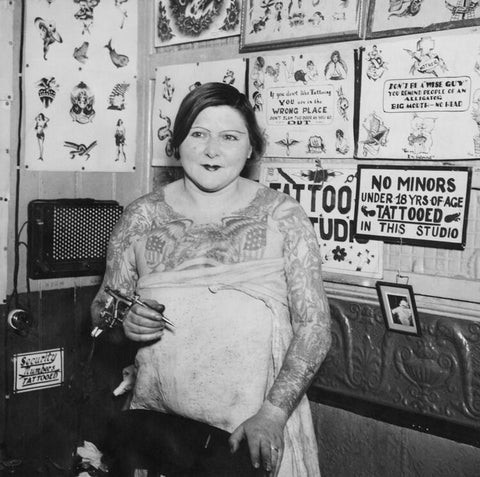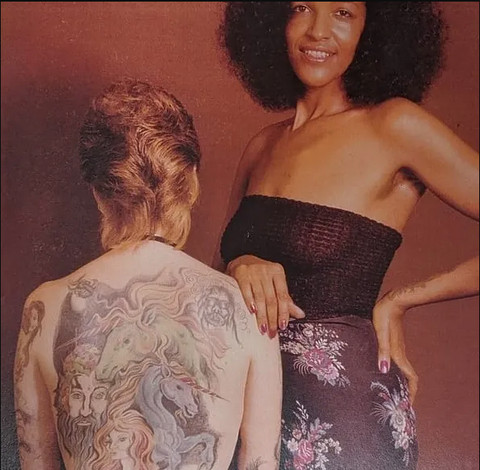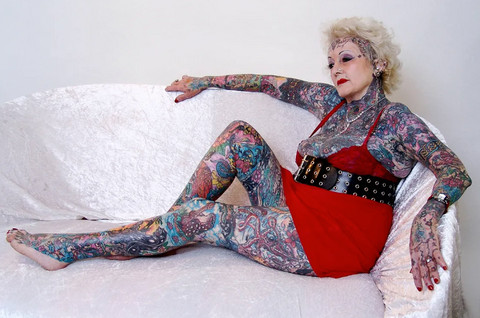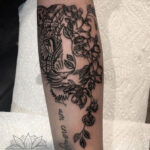Even in the early 2000s, choosing to get tattooed carried a rebellious edge. Questions like “Are you turning into a bad girl?” were not uncommon, reflecting a lingering perception of tattoos as transgressive, especially for women. However, tattoos for women are far from a fleeting trend; they are deeply rooted in history and connected to evolving narratives of female empowerment and self-expression.
Margot Mifflin, in her seminal work Bodies of Subversion: a secret history of women and tattoos, eloquently captures this sentiment: “Tattoos appeal to contemporary women both as emblems of empowerment in an era of feminist gains and as badges of self-determination at a time when controversies about abortion rights, date rape, and sexual harassment have made them think hard about who controls their bodies – and why.” This perspective highlights the powerful connection between tattoos and a woman’s assertion of autonomy over her own body.
Interestingly, the story of Tattoo Women is not a modern invention. Delving into the archives of 1879 New York, we find a fascinating glimpse into this history in The National Police Gazette. An article titled ‘The Tattoo Trick’ reported on a female tattoo artist operating discreetly in a respectable neighborhood. She revealed a thriving business, with women making up the majority of her clientele. This historical anecdote underscores that women and tattoos have a long and intertwined history, often hidden beneath the surface of mainstream narratives.
These historical glimpses ignite a powerful curiosity. Old photographs of tattooed women, faded sepia-toned portraits, draw us in. We are compelled to ask: Who were these women? What drew them to the needle? What societal judgments did they face? To truly understand the landscape of modern tattooing for women, we must acknowledge and honor the pioneers who paved the way.
Let’s step back in time and celebrate some of these iconic figures – the tattoo women of the past who have shaped the vibrant and empowering tattoo culture we see today. These are women who, often in eras of significant social constraints, embraced ink as a form of self-expression and rebellion. Imagine the audacity, the sheer force of will, it took for women in the early 1900s, with limited rights and societal expectations firmly placed upon them, to adorn their skin, and even tattoo others. This is not just tattoo history; this is tattoo herstory.
Maud Wagner: Circus Performer Turned Tattoo Legend
Maud Wagner’s journey into tattooing is as captivating as her ink. Beginning as a circus performer skilled in aerial acrobatics and contortion, her life took a turn in 1904 when she met tattoo artist Gus Wagner. Their courtship was unconventional: Maud agreed to a date on the condition that Gus would teach her the art of tattooing. Marrying Gus, she fully embraced the craft, becoming a tattooist in 1907, mastering the traditional stick and poke method. Maud herself became heavily tattooed, embodying the art form she practiced and contributing to the legacy of early women in tattooing. Her story highlights the adventurous spirit and independent nature often associated with women who chose tattoos in a restrictive era.
Jessie Knight: The UK’s Pioneering Female Tattooist
Jessie Knight holds the esteemed title of the UK’s first known female tattoo artist. Starting her tattooing journey in 1921 at the young age of 17, Jessie learned the craft from her father, a sailor and tattooist. When her father was at sea, she confidently took charge of his tattoo shop in Barry, South Wales. Navigating the social stigma surrounding women in tattooing, Jessie adopted a professional image, wearing suits and maintaining impeccable grooming. Despite facing prejudice, even being called names like “vampire” and “nasty cat” as reflected in her diary poems from the 1940s, Jessie persevered. Her career spanned decades, tattooing well into the 1980s and managing multiple shops, solidifying her place as a formidable figure in tattoo history and an inspiration for women in traditionally male-dominated fields.
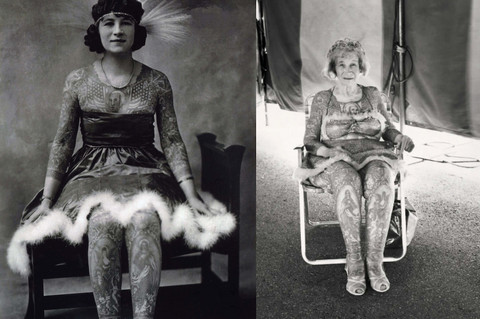
Artoria Gibbons: The Tattooed Lady of the Stage
Artoria Gibbons carved her niche as a performing tattooed lady, captivating audiences with her living art. To heighten the drama of her stage presence, a fictional backstory was often fabricated: that she was tattooed against her will by a possessive, older husband to deter other men. The reality was far more empowering. Artoria and her husband, Charles “Red” Gibbons, a well-known tattoo artist, strategically collaborated. Recognizing the public fascination with tattooed performers, they decided Artoria would become a professional tattooed lady. Charles tattooed her extensively in vibrant color, covering her body with reproductions of her favorite religious artworks, including masterpieces like Botticelli’s The Annunciation and Michelangelo’s Doni Tondo. Artoria’s performances spanned decades, beginning in the 1920s and continuing until her retirement in 1981, showcasing her as a captivating entertainer and a walking canvas of art history.
Mildred Hull: New York’s Independent Female Tattooist
Mildred “Millie” Hull, born in 1897, distinguished herself as a true pioneer. A former burlesque dancer, Millie is recognized as one of the first women to independently learn tattooing, without relying on a male partner or relative for instruction. She catered to a largely female clientele, often inking popular designs like hearts with lovers’ names and “mother” tattoos. In 1943, she was notably recognized as New York City’s only female tattooist – remarkable considering tattooing was illegal in NYC until 1997. In a Foto Magazine interview, Millie offered an insightful perspective on her clientele: “I think men rather like having a woman tattoo them. They think a woman is likely to be more careful.” Her words provide a glimpse into the evolving perceptions of female tattoo artists and their unique approach. Sadly, Mildred’s life ended tragically in 1947.
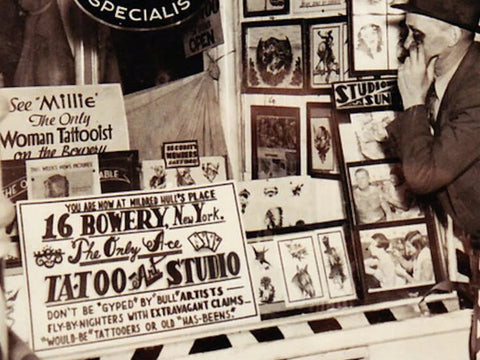
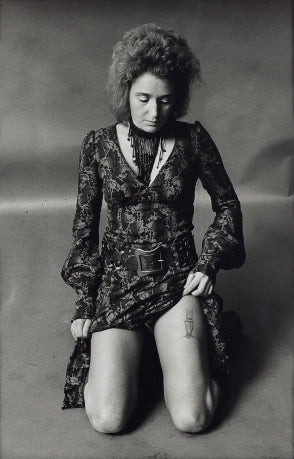
Valie Export: Tattoo as Feminist Statement
Valie Export, an Austrian avant-garde artist, used her body as a canvas for powerful feminist statements. In a performance piece in Frankfurt in July 1970, Valie publicly tattooed a suspender belt design onto her thigh. This act was deliberate and symbolic, intended to critique the objectification of women and the societal constraints placed upon them. “Tattooing the body demonstrates the connection between ritual and civilization,” she wrote, reflecting on her work. “In the tattoo the garter appears as a sign of a past enslavement, clothing as the suppression of sexuality, the garter as an attribute of a femininity not determined by ourselves.” Valie Export’s tattoo was not merely body art; it was a bold declaration, using ink to challenge societal norms and spark dialogue about female identity and liberation.
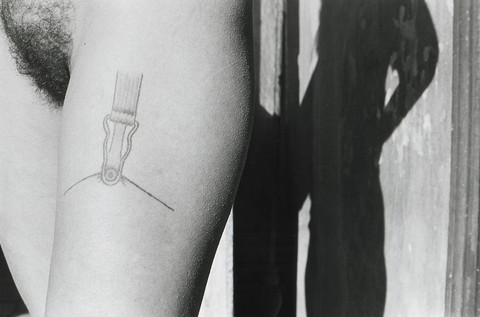
Jacci Gresham: Breaking Barriers in Ink
Jacci Gresham holds a significant place in tattoo history as the USA’s first Black female tattoo artist. Learning to tattoo in 1972, Jacci entered an industry that was not only heavily dominated by men but also overwhelmingly white. Her achievement is monumental, breaking down racial and gender barriers within the tattoo community. Her shop, Aart Accent Tattoos, in New Orleans, is not just a business; it is a landmark, the first tattoo shop opened by a Black woman in the United States. Even in her 70s, Jacci continues to tattoo, embodying resilience and dedication to her craft. Her shop’s catchy slogan, “Look better naked – get a tattoo,” reflects a confident and playful approach to body art, further solidifying her iconic status.
Isobel Varley: The World’s Most Tattooed Senior Citizen
Isobel Varley’s tattoo journey began later in life, but became an all-consuming passion. “Originally, I was only ever going to have one – a small bird – but I fell in love with it, and developed an addiction,” Isobel confessed upon being recognized as the world’s most tattooed female pensioner. A former secretary, Isobel became renowned for having 93% of her body covered in tattoos, earning her a Guinness World Record as the most tattooed female senior citizen. She received her first tattoo at age 49 in 1986, sparking a “bug” that led to over 200 tattoos in a decade. Her beloved tattoos included a family of tigers on her stomach. Isobel passed away in 2015 at 77, leaving behind a legacy of embracing self-expression at any age and challenging societal norms around aging and body modification.
These women, each unique in their stories and styles, collectively represent a powerful narrative of women and tattoos. They were pioneers, rebels, artists, and entrepreneurs who defied expectations and shaped the landscape of tattoo culture. Their legacies continue to inspire and empower women today to embrace tattoos as a form of self-expression, artistry, and personal empowerment.
